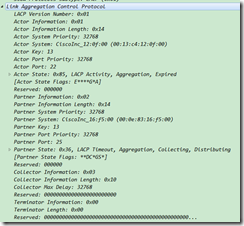首页 > 代码库 > LACP基础
LACP基础
文档简介:
以华为LACP协议在交换机的应用为主,横向对比其他厂家配置,以及与其他厂家lacp对接的实现。
一、维基百科解释
链路聚合(英语: Link Aggregation )是一个计算机网络术语,指将多个物理端口汇聚在一起,形成一个逻辑端口,以实现出/入流量吞吐量在各成员端口的负荷分担,交换机根据用户配置的端口负荷分担策略决定网络封包从哪个成员端口发送到对端的交换机。当交换机检测到其中一个成员端口的链路发生故障时,就停止在此端口上发送封包,并根据负荷分担策略在剩下的链路中重新计算报文的发送端口,故障端口恢复后再次担任收发端口。链路聚合在增加链路带宽、实现链路传输弹性和工程冗余等方面是一项很重要的技术。
二、Eth-Trunk基本配置
![]()
<HUAWEI> system-view
[~HUAWEI] interface eth-trunk 1
[*HUAWEI-Eth-Trunk1] mode lacp-static
[*HUAWEI-Eth-Trunk1] trunkport 10ge 1/0/1 to 1/0/3
[*HUAWEI-Eth-Trunk1] commit
[~HUAWEI-Eth-Trunk1] quit
华为的设备支持 两种Eth-trunk工作模式:
手工负载分担模式
LACP模式:静态和动态
手工负载分担(Manual load-balance)模式下,Eth-Trunk的建立、成员接口的加入由手工配置,没有LACP(link Aggregation Control Protocol)协议报文的参与。该模式下所有活动链路都参与数据的转发,平均分担流量,因此称为负载分担模式。如果某条活动链路故障,链路聚合组自动在剩余的活动链路中平均分担流量,当需要在两个直连设备间提供一个较大的链路带宽而设备又不支持LACP协议时,可以使用手工负载分担模式。
静态LACP(Static LACP)模式是一种利用LACP协议进行聚合参数协商、确定活动接口和非活动接口的链路聚合方式。
该模式下,需手工创建Eth-Trunk,手工加入Eth-Trunk成员接口,由LACP协议协商确定活动接口和非活动接口。
静态LACP模式也称为M∶N模式。这种方式同时可以实现链路负载分担和链路冗余备份的双重功能。在链路聚合组中M条链路处于活动状态,这些链路负责转发数据并进行负载分担,另外N条链路处于非活动状态作为备份链路,不转发数据。当M条链路中有链路出现故障时,系统会从N条备份链路中选择优先级最高的接替出现故障的链路,同时这条替换故障链路的备份链路状态变为活动状态开始转发数据。
和静态LACP模式相对应的还包括动态LACP模式。动态LACP模式的链路聚合,从Eth-Trunk的创建到加入成员接口都不需要人工的干预,由LACP协议自动协商完成。一般用在跟服务器对接。
三、LACP 报文格式



四、华为跟其他厂家lacp模式对接表
Cisco 工作模式 | Huawei 工作模式 |
on | manual(缺省模式) |
active(LACP) | lacp-static |
passive(LACP) | lacp-static |
atuo(PAgP) | 不支持对接 |
desirable(PAgP) | 不支持对接 |
备注:
其他厂家如H3C、ZTE类似主要的区别就在于huawei LACP-STATIC对应的是其他厂家dynamic模式。
案例:
摘录自华为CE12800文档
组网图
图1 华为设备对接(或替换)CISCO设备
操作步骤
创建链路聚合组,配置LACP模式并将接口加入Eth-Trunk。
# 配置华为设备。
<HUAWEI> system-view [~HUAWEI] interface eth-trunk 1 [*HUAWEI-Eth-Trunk1] mode lacp-static [*HUAWEI-Eth-Trunk1] trunkport 10ge 1/0/1 to 1/0/3 [*HUAWEI-Eth-Trunk1] commit [~HUAWEI-Eth-Trunk1] quit
# 配置CISCO设备。
CISCO#configure terminal CISCO(config)#interface port-channel 1 CISCO(config-if)#exit CISCO(config)#interface range gigabitEthernet 0/1, gigabitEthernet 0/2, gigabitEthernet 0/3 CISCO(config-if-range)#channel-protocol lacp CISCO(config-if-range)#channel-group 1 mode active CISCO(config-if-range)#exit CISCO(config)#exit
# 查看华为设备。
[~HUAWEI] display eth-trunk 1Eth-Trunk1‘s state information is: Local: LAG ID: 1 Working Mode: Static System Priority: 32768 System ID: 0025-9e95-7c31 Operating Status: up Number Of Up Ports In Trunk: 3 Timeout Period: Slow -------------------------------------------------------------------------------- ActorPortName Status PortType PortPri PortNo PortKey PortState Weight 10GE1/0/1 Selected 1GE 32768 1 20289 10111100 1 10GE1/0/2 Selected 1GE 32768 2 20289 10111100 1 10GE1/0/3 Selected 1GE 32768 3 20289 10100000 1 Partner: ActorPortName SysPri SystemID PortPri PortNo PortKey PortState 10GE1/0/1 32768 0025-9e95-7c11 32768 0 20289 10111100 10GE1/0/2 32768 0025-9e95-7c11 32768 0 20289 10111100 10GE1/0/3 32768 0025-9e95-7c11 32768 0 20289 10100000
# 查看CISCO设备。
CISCO#show etherchannel 1 port-channel Port-channels in the group: --------------------------- Port-channel: Po1 (Primary Aggregator) ------------ Age of the Port-channel = 0d:05h:03m:48s Logical slot/port = 2/1 Number of ports = 3 HotStandBy port =null Port state = Port-channel Ag-Inuse Protocol = LACP Port security = Disabled Ports in the Port-channel: Index Load Port EC state No of bits ------+-------------+-----------+----------------------------------------------- 0 00 Gi0/1 Active 0 0 00 Gi0/2 Active 0 0 00 Gi0/3 Active 0 Time since last port bundled: 0d:00h:44m:09s Gi0/3 Time since last port Un-bundled: 0d:00h:44m:13s Gi0/3
本文出自 “Benny的技术博客” 博客,请务必保留此出处http://benny27.blog.51cto.com/11349752/1952401
LACP基础
